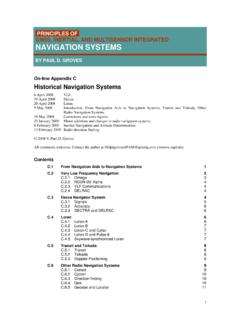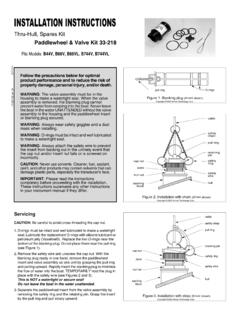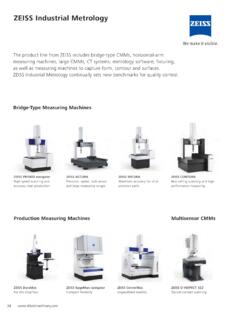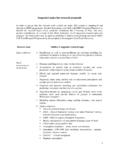Transcription of Installation B E EVC 1(1) Electronic Vessel Control Volvo ...
1 EVCEC-CElectronic Vessel ControlVolvo Penta IPSI nstallation1(1)B EInstallation Electronic Vessel Control EVCEC-C Volvo Penta IPS 350/400/450/500/600 ContentsSafety precautions .. 5 General information .. 7 Engine monitoring and the EVC system .. 0 Engine monitoring system .. 0 The EVC-C system .. Installation tools and literature .. 3 Other special equipment .. 4 Major components .. 5 Electronic controls .. 5 Key switch .. 5 Steering system .. 5 EVC Control panel .. 6 Docking station panel.
2 6 Start/stop panel .. 6 Instruments .. 7 EVC system display .. 8 Multisensors .. 8 Auxiliary dimmer unit (ADU) .. 9 Autopilot interface .. 9 NMEA 0 83 interface .. 9 NMEA 000 interface .. 9 Relay for external accessories .. 9 Buzzer .. 9 Fuel level and fresh water level sender .. 0 PCU and HCU .. 0 Cables and cable harnesses .. Extension cables .. 4 Installation procedure, general .. 5 Cable routing .. 6 Marking and color coding of cables .. 9 Building an EVC network .. 30 Identification of the PCU and the HCU.
3 3 007 AB Volvo PENTAAll rights to changes or modifications on environmentally-friendly paper3 Contents cont. Installation procedure, engine room .. 3 Location and mounting of the PCU and HCU . 3 Engine PCU cable .. 33 Transmission cable incl. solenoid coils .. 33 Steering cables .. 34 Power supply .. 35 PCU Installation .. 35 Fuel and fresh water level senders .. 35 Standard bus cable PCU HCU .. 38 HCU Installation .. 38 Installaltion procedure, helm .. 39 Y-connector location .. 39 Key switch.
4 39 Start/stop panel .. 40 EVC Control panel .. 4 Docking station panel .. 43 Relay for external accessories .. 44 Instruments .. 46 Buzzer .. 49 Auxiliary dimmer unit (ADU) .. 50 Synchronizing cable, twin installations .. 5 EVC system display .. 5 NMEA 0 83 interface .. 56 NMEA 000 interface .. 57 Autopilot gateway .. 59 Multisensor .. 60 Controls, Electronic .. 6 Steering system .. 6 Joystick unit .. 65 EVC Control panels .. 68 EVC Control panel .. 68 Docking station panel .. 69 Calibration and settings.
5 70 General .. 70 Calibration mode .. 7 Auto configuration .. 73 Lever calibaration .. 73 Select language and units .. 74 Idling speed calibration .. 75 OEM-mode .. 76 Fuel tank settings .. 76 Fuel tank calibration .. 77 Multisensor calibration .. 79 IPS drive leg positions .. 8 Steering mode setting .. 83 EVC system display .. 84 Diagnostic function .. 89 Fault register .. 9 Parameter settings .. 00 Starting the engine .. 0 Wiring color and pin-out schematics .. 04 Templates for controls and panels.
6 05 References to Service bulletins .. 84 Contents EVC-CImportant!The following special warning symbols are found in this manual and on the engine. WARNING! Possible danger of personal injury, damage to property or mechanical malfunction if the instructions are not followed. IMPORTANT! Used to draw your attention to something that can cause damage to or malfunc-tion of a product or damage to ! Used to draw your attention to important in-formation that will facilitate the work or operation in summary is given below of the risks and safety pre-cautions you must observe or carry out when install-ing and calibrating the EVC system.
7 IMPORTANT! Before carrying out electric arc welding, remove the connector from the engine Control precautionsIntroductionThis Installation Manual contains the information you will need to install and test the Electronic Vessel Con-trol (EVC) this Installation Manual carefully before instal-lation. Incorrect Installation may result in personal injury or damage to property or the engine you do not understand or are uncertain about any operation or information in this Installation Manual, please contact the Volvo Penta Installation Manual is intended for professional use Manual must be used in conjunction with the rel-evant Engine Operator s Penta will not assume any liability for damage to materials or personal injury.
8 Which may result if the Installation instructions are not followed or if the work is carried out by non-professional installer is responsible for ensuring that the system operates in accordance with this Installation Manual. Work proceduresThese instructions are for use by suitably qualified personnel, referred to as the installer in these to the specific Engine Operator s manual for relevant information where necessary, especially re-garding safety and engine work must be done at Volvo Penta s service workshops, boat builders or other authorised and suitably equipped workshops with personnel who have the appropriate qualifications and and D6 enginesPress the lock tab down and pull the connector out.
9 Refit the connector to the engine Control unit after disconnecting the welding care to avoid all moving parts of the engine during testing and operation. Approaching an engine which is operating is a hazard to personal safety. Loose clothing or long hair can become entangled in moving parts, and may cause seri-ous personal injury. Never carry out work on an engine that is sus-pended from a hoist. The engine must not be run in areas where there are explosive materials or gases. Only start the engine in a well-ventilated area.
10 If operating the engine in a closed area ensure that there is exhaust ventilation leading out of the work area to remove exhaust gases and crank-case ventilation emissions. Never allow an open flame or electric sparks near the batteries. Never smoke close to the bat-teries. The batteries give off hydrogen gas during charging, which can form an explosive mixture when mixed with air . This gas is easily ignited and highly flammable. Incorrect connection of the battery can cause a single spark, which is sufficient to cause a gas explosion.




